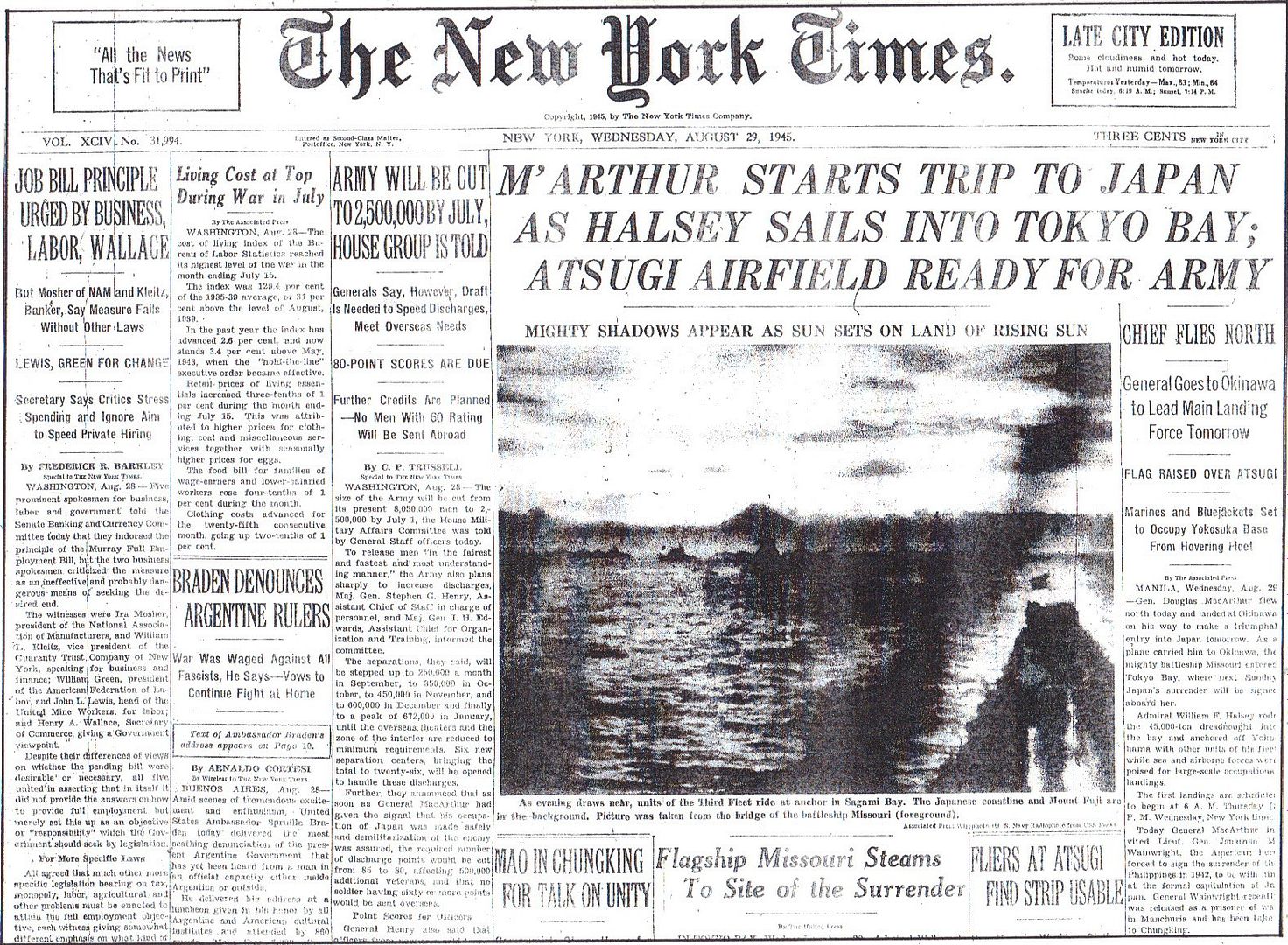
Posted on 08/29/2015 4:37:37 AM PDT by Homer_J_Simpson

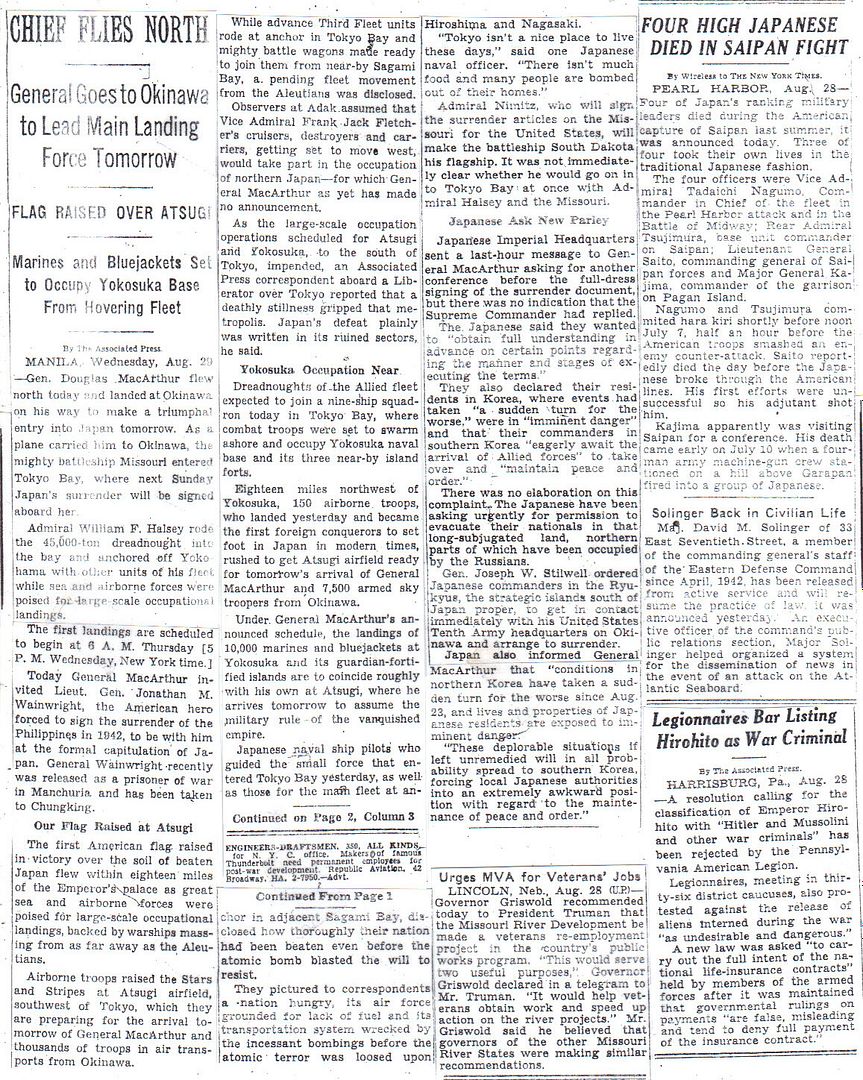
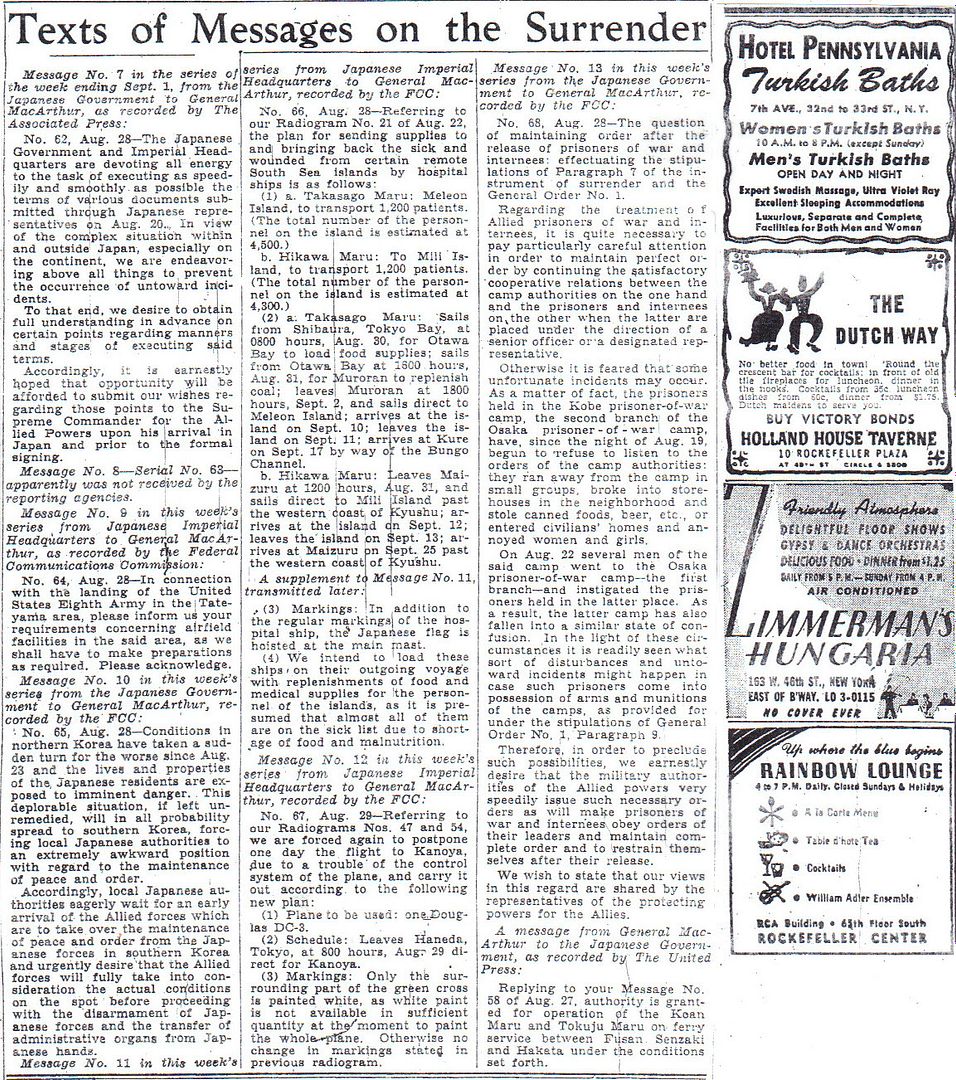
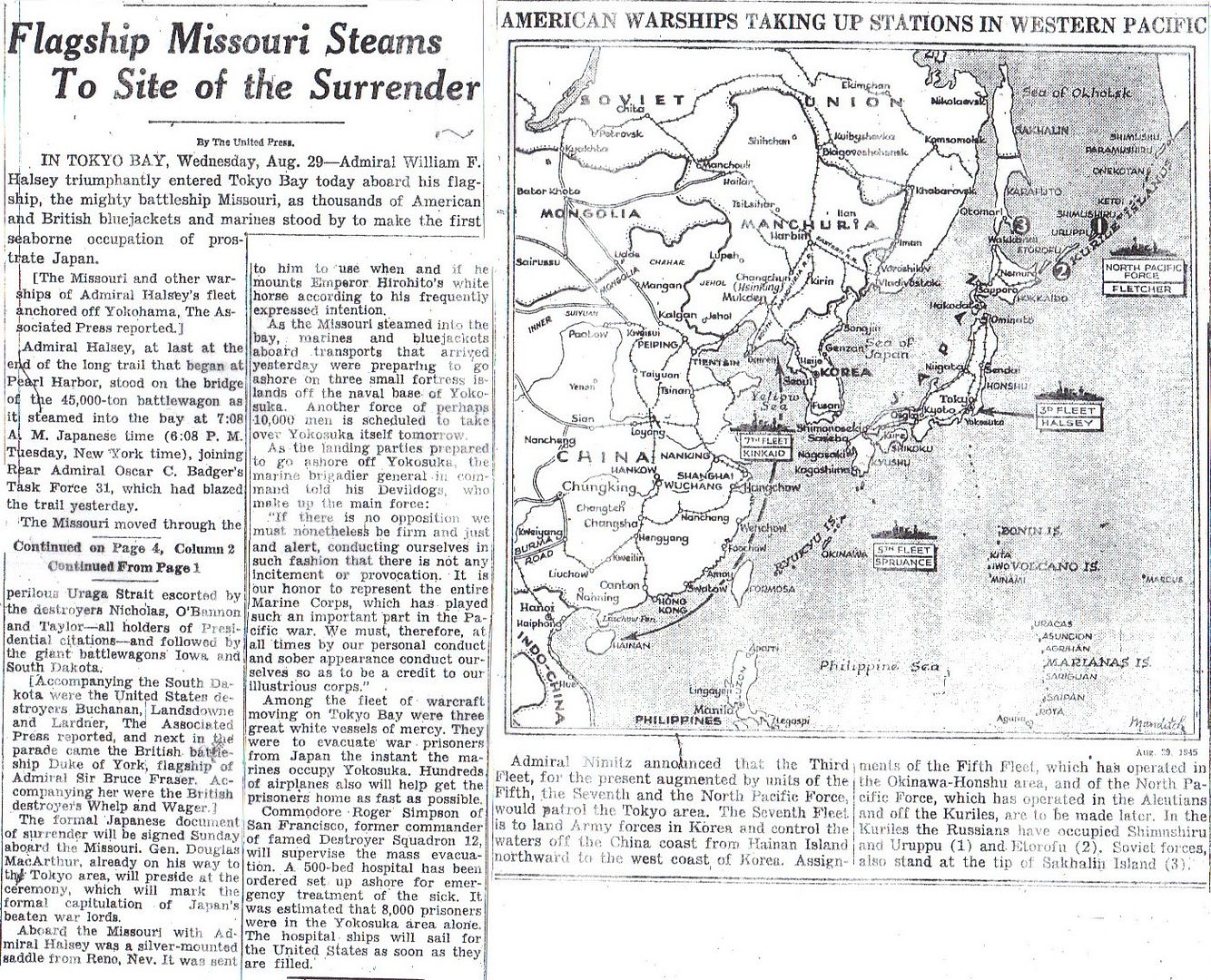
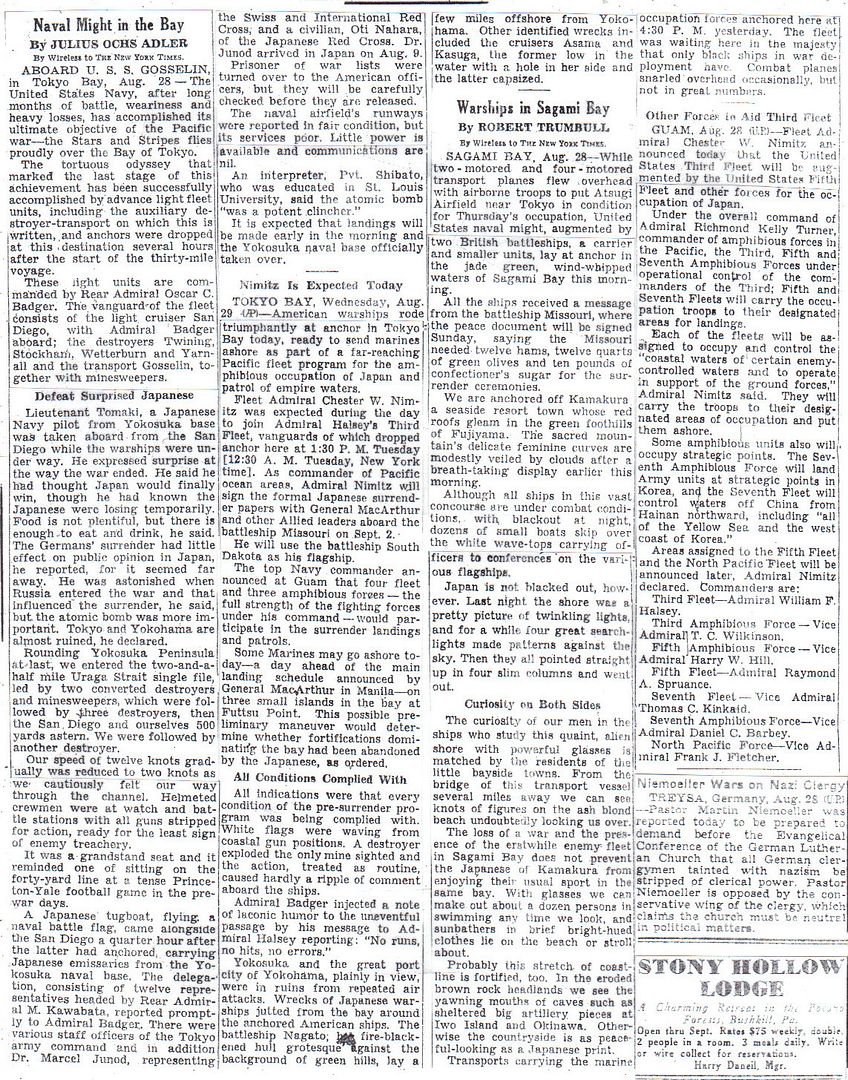
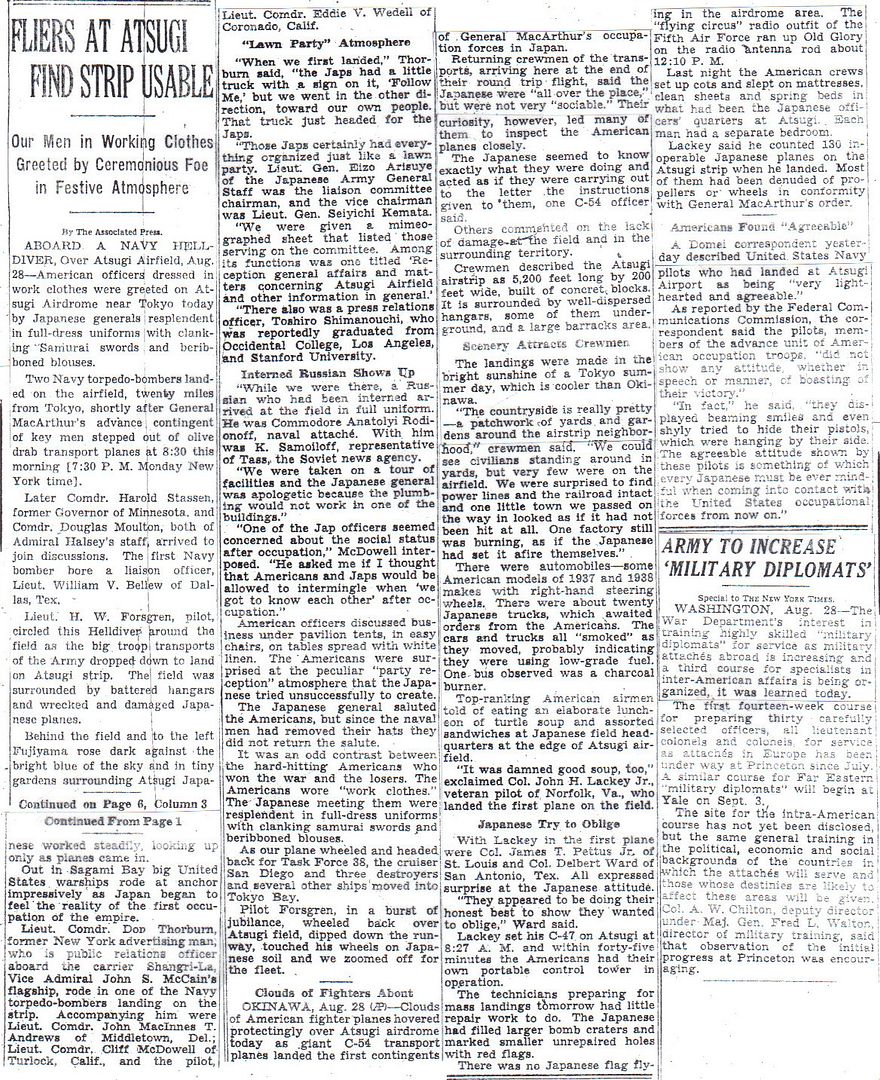
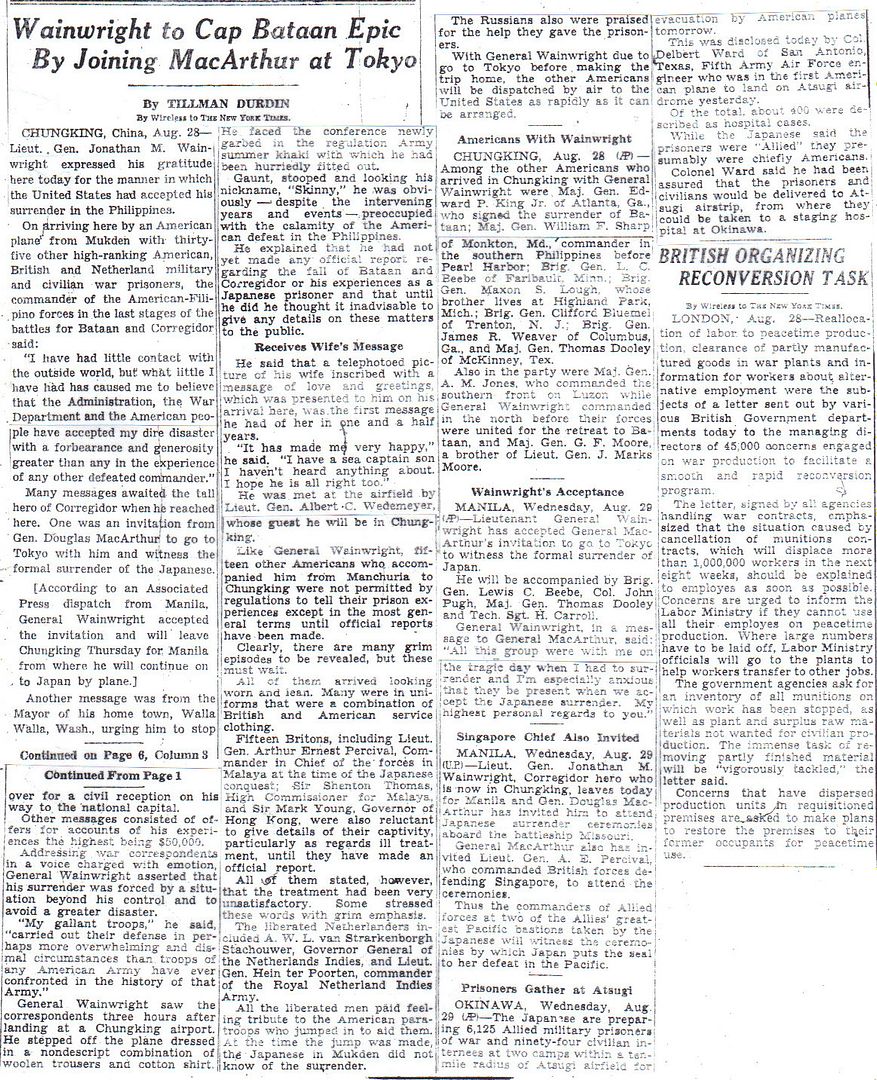

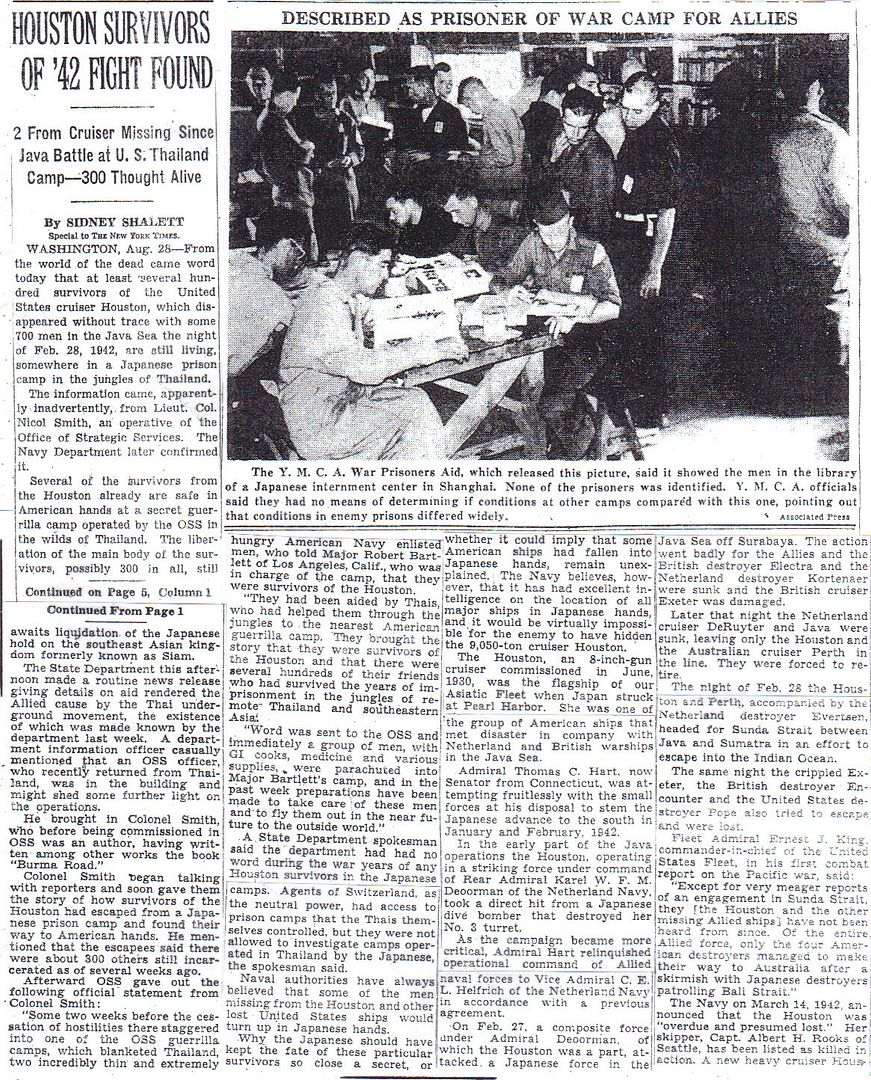
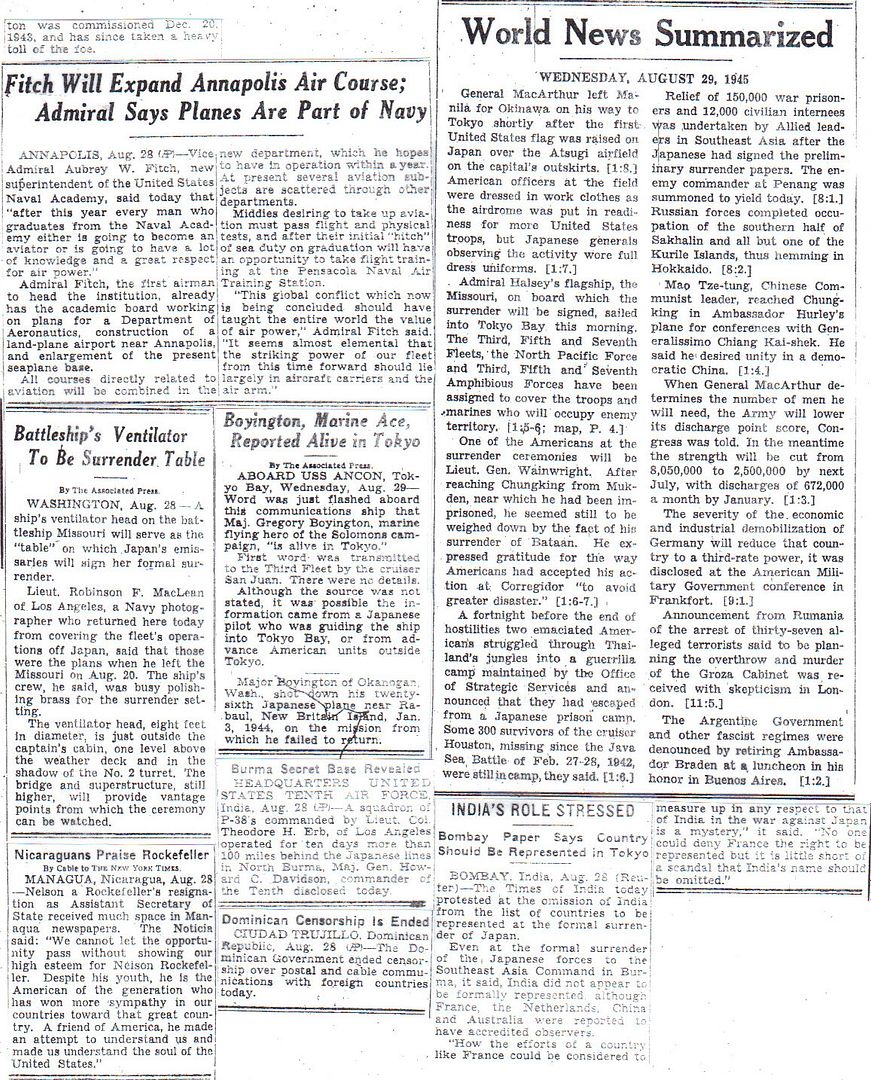
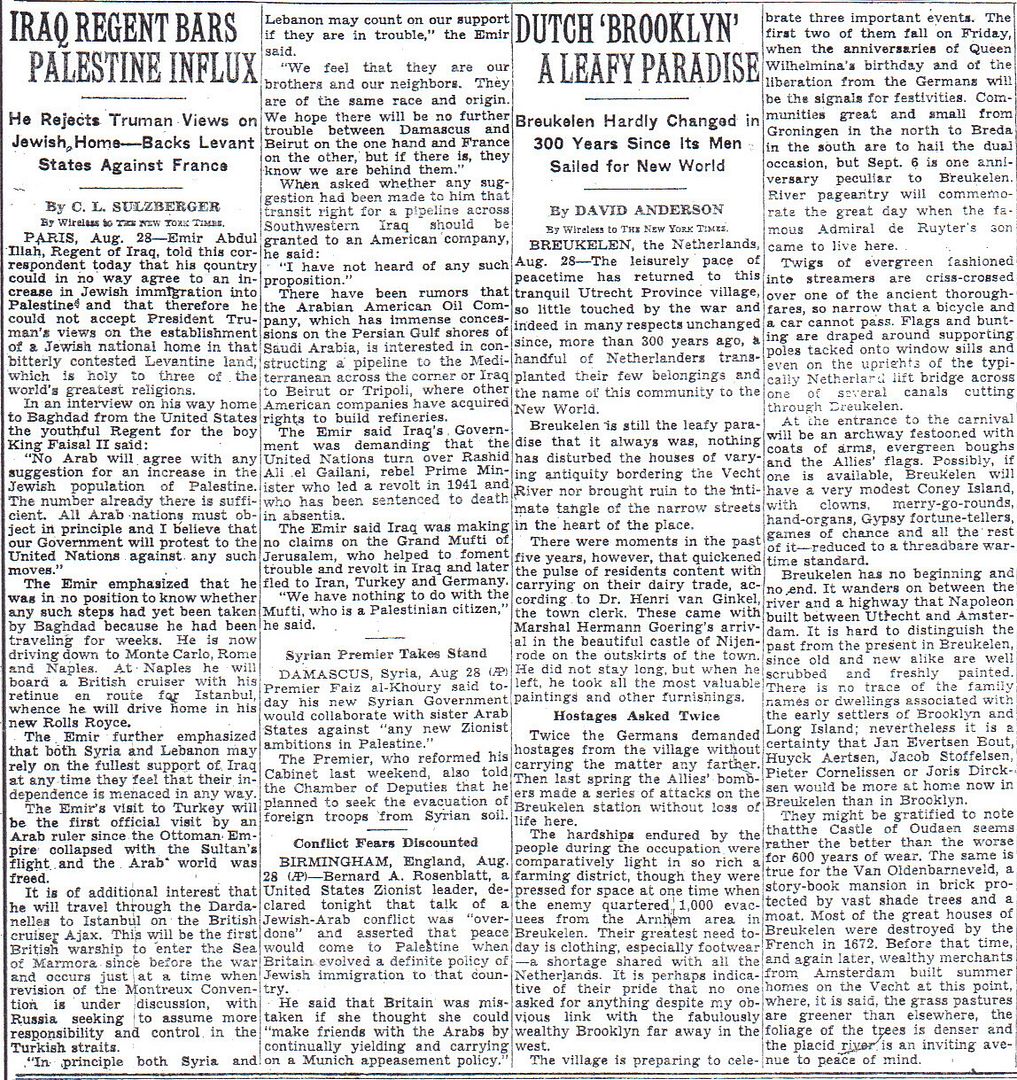
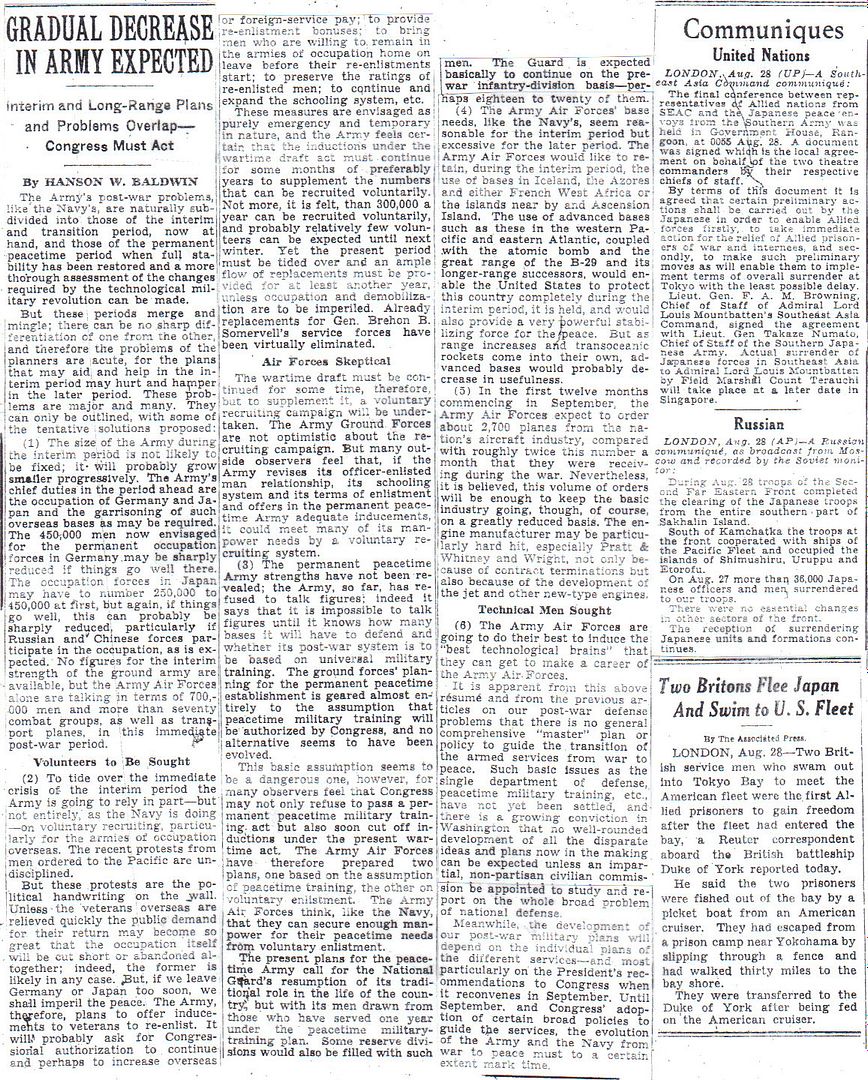
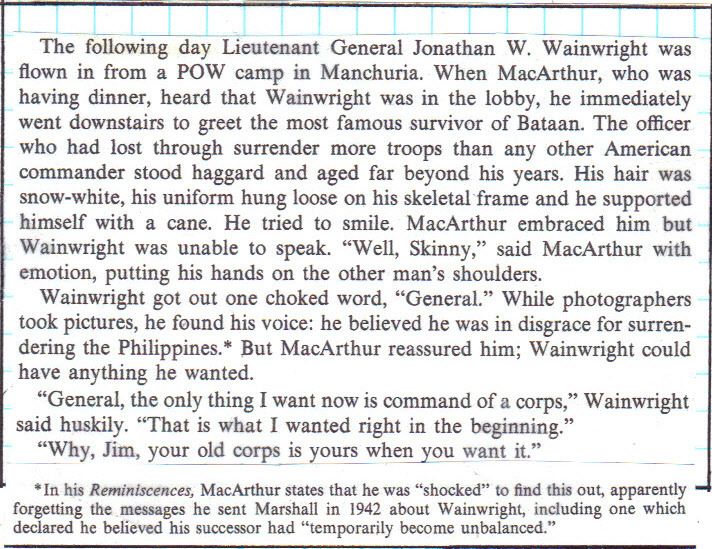
John Toland, The Rising Sun: The Decline and Fall of the Japanese Empire, 1936-1945
http://www.etherit.co.uk/month/7/29.htm
August 29th, 1945 (WEDNESDAY)
HONG KONG: The British fleet arrives to reclaim the colony for Britain.
CHINA: Mao Tse-tung and Chiang Kai-shek meet at Chungking for talks to try to avert civil war between the Communists and the Nationalists.
SINGAPORE: Japanese troops in southeast Asia, numbering about 740,000, surrender in Singapore to British Admiral Lord Louis Mountbatten, Supreme Allied Commander Southeast Asia. General ITAGAKI Seishiro, Commander of the 7th Area Army, signs the document for the Japanese.
JAPAN: In the Kurile Islands, Soviet forces occupy Etorofu Island. The Japanese garrisons on Halmahera and Morotai Islands surrender. The first Allied prisoners in Japan are liberated by USN forces.
The USN’s Task Group 30.6 commanded by Commodore Rodger W. Simpson arrives in Tokyo Bay to undertake emergency evacuation of Allied POWs in waterfront areas. Accompanying Commodore Simpson was Commander Harold E. Stassen, USNR, Flag Secretary to Commander, Third Fleet, Admiral William F. Halsey.
Guided by TBM Avengers from the light aircraft carrier USS Cowpens (CVL-25) and taken to the scene in LCVPs from the high speed transport USS Gosselin (APD-126), Commodore Simpson carries out his orders. The appearance of the LCVPs off the camp at Omori (the first liberated) triggers “an indescribable scene of jubilation and emotion” by the former captives, some of whom swim out to the approaching landing craft. Many of the POWs, suffering from malnutrition and other health problems, required immediate medical care and the hospital ship USS Benevolence (AH-13) is stationed nearby to receive them. Their treatment as POWs was described as an “inquisitional form of barbarism.”
The battleship USS Missouri anchors in Tokyo Bay.
Off Japan, the USN submarine Segundo (SS-398) encounters Japanese submarine HIJMS I-401 off the northeast coast of Honshu, and “after considerable negotiation,” places prize crew on board.
EAST INDIES: The Japanese garrisons on Halmahera and Morotai Islands in the Netherlands East Indies surrender.
U.S.A.: Secret Army and Navy reports of official enquiries into the raid on Pearl Harbor on 7 December 1941 are made public. The blame is placed on a lack of preparedness, confusion and a breakdown of inter-service coordination. Former Secretary of State Cordell Hull, General of the Army George C. Marshall, Chief of Staff, U.S. Army, and former Chief of Naval Operations (CNO) Admiral Harold R. Stark are criticized. President Harry S. Truman objects to the findings on Hull and Marshall.
bookmark
Before that, he was interned at the Ofuna prison camp, just north of Kamakura, alongside Louis Zamperini of recent movie fame. Ofuna today is primarily famous for a huge bust of Kannon (Ch. kwan yin), the goddess of mercy in Buddhist lore. The prisoners would not have seen the statue, because while it was begun in the 1920s, its construction was halted in the early 30s and was not resumed until after the war.
One of the people instrumental in beginning the project in the late 1920 was Kentaro Kaneko. Kaneko was the highest-ranking official pushing for a Japan-America alliance in the 1920s and 30s, and fought vehemently against Japan provoking war with America. This was in part because he had been to Harvard in the 1880s, and was instrumental in getting Teddy Roosevelt to broker the peace treaty between Russia and Japan in 1905.
As I've written before, WWII would have been a very different experience if Hirohito had listened to people like Kaneko, and decided to ally Japan with Chiang Kai-Shek and FDR in the 30s, instead of turning into an Asian Hitler and using tyranny and genocide in attempting to conquer Asia and the Pacific. One of the reasons Japan goes in the direction it does is the other major player in commencing the Ofuna Kannon project, Mitsuru Toyama, who was behind every nationalist underground movement from the 1880s to the 1940s, from the Genyosha and Tenyukai to the Black Dragon Society, which he never publicly joined but almost certainly pulled the strings from behind the scenes.
In short, Kaneko and Toyama joining together in the late 1920s on a project like the Ofuna Kannon would be a bit like Daniel Leo and Mitt Romney joining together to support the construction of a huge statue of Mary overlooking Wilmington, within view of the Acela--and I say that because every time I have ridden the Yokosuka Line train between Yokohama and Zushi/Yokosuka, I could see the Kannon from the train window as it stopped at Ofuna station.
P.S. One thing Toyama and Kaneko had in common: they both died after Pearl Harbor and before Hiroshima, so neither was involved in postwar Japan.
Every day I thank God for what my father did, not once but twice: first, for being part of the force that destroyed the evil empire of Japan, and second, for swallowing his vengeful anger and being part of the combined force that protected both the US and Japan from the evil empire of communism.
And I'll say one more thing before virtually commuting to my online work: for the first time in a very long while, I am beginning to think that America will become once again the force for good, that the American people will rise again and show once again the strength of their WWII forefathers. It's because of Trump. Not Trump himself: he is a side-show. Maybe he is a leader and maybe he is not, but what he has done is unchained the American people to again be themselves, the no-nonsense, git 'r dun people who can tell the difference between good and evil, and who bring good to the world while being, as Domei put it on #6, "light-hearted and agreeable." The American people have always been there, and we are about to show ourselves again.
“General, the only thing I want right now is command of a corp.” Wainwright said huskily.
http://military.wikia.com/wiki/Jonathan_M._Wainwright_(general)
Post-War years and retirement
On September 5, 1945, shortly after the Japanese surrender, Wainwright received his fourth star. On September 13, a ticker-tape parade in New York City was held in his honor. Upon returning to the United States, he was assigned as commander of Second Service Command and the Eastern Defense Command at Fort Jay, Governors Island, New York. In January 1946, he became the commander of the Fourth Army at Fort Sam Houston, Texas where he retired in August 1947. He became a Freemason in May 1946 at Union Lodge No. 7. in Junction City Kansas and a Shriner soon after.[5][6][7][8][9] Wainwright was also a Hereditary Companion of the Military Order of the Loyal Legion of the United States by right of his grandfather’s service in the Union Navy during the Civil War.
Wainwright served on the board of directors for several corporations after his retirement. He made himself available to speak before veterans’ groups and filled almost every request to do so. He never felt any bitterness toward MacArthur for his actions in the Philippines or MacArthur’s attempt to deny him the Medal of Honor. In fact, when it appeared that MacArthur might be nominated for president at the 1948 Republican National Convention, Wainwright stood ready to make the nominating speech.[2]
He died of a stroke at San Antonio, Texas on September 2, 1953. Wainwright was buried in Section 1 of Arlington National Cemetery with a Masonic service and is one of the few people to have had their funeral held in the lower level of the Memorial Amphitheater. He is buried next to his wife and near his parents.
A little background here on the confusion of surrender for General Wainwright:
http://www.history.army.mil/books/wwii/5-2/5-2_32.htm
General Wainwright’s Orders
Unlike General King, who had been forced to violate his instructions and keep from his superior any knowledge of his decision to surrender the Luzon Force, Wainwright was able to make his decision unhindered by restrictions from higher headquarters. He had not always had this freedom of action. Until 9 April he had been bound, as had General MacArthur before him, by President Roosevelt’s order “to fight as long as there remains any possibility of resistance.”1 On that day, the day of General King’s surrender, the President modified this order and gave General Wainwright full authority to act on his own judgment.
The decision to change Wainwright’s instructions had been initiated in Washington just before the surrender of Bataan. Alerted by reports from MacArthur and Wainwright, Maj. Gen. Joseph T. McNarney, acting in Marshall’s absence, had informed the President on 8 April (Washington time) that the situation on Bataan was extremely serious and the collapse of its defense imminent. Reminding President Roosevelt of his instructions to MacArthur, “issued at a time when it appeared necessary to make very clear . . . the nature of the defense expected,” McNarney suggested that the President might wish now to modify these instructions. “It is possible,” he wrote, “that in the literal execution of these orders General Wainwright may be tempted to carry them through to an illogical extreme. I think there should be no doubt that his resolution and sense of duty will preclude any untoward or precipitous action, but on the other hand, it is possible that greater latitude in the final decision should be allowed him.”2
President Roosevelt accepted McNarney’s suggestion readily, and that same day, 8 April-the 9th, Philippine time-approved the text of a message for Wainwright modifying his earlier instructions. Explaining that he was changing his orders “because of the state to which your forces have been reduced by circumstances over which you have had no control,” the President told Wainwright that he was free to make “any decision affecting the future of the Bataan garrison.” “I . . . have every confidence,” the President wrote, “that whatever decision you may sooner or later be forced to make will be dictated only by the best interests of your country and your magnificent troops.”3
Roosevelt’s message to Wainwright was not sent directly to Corregidor but went instead to General MacArthur in Australia with instructions that it be forwarded to Corregidor if he, MacArthur, concurred “both as to substance and timing.”4 The message reached MacArthur at about the same time as Wainwright’s dispatch carrying the news that Bataan had surrendered. Since, in his view, “the action taken on Bataan anticipated the authority conveyed in the message,” he saw no need to change Wainwright’s instructions.5 In effect, this was a “non-concurrence” of the President’s message to Wainwright, which remained on his desk.
But the progress of events had already invalidated MacArthur’s decision. The President, on hearing news of the surrender of Bataan and before receiving MacArthur’s reply, apparently decided that Wainwright needed assurance of support immediately and he sent him the text of his message, including the instructions given MacArthur, from whom, he explained, no reply had yet been received. “Whatever decision you have made,” Roosevelt told Wainwright, “has been dictated by the best interests of your troops and of the country.” He then went on to express the hope that Wainwright would be able to hold Corregidor, but assured him “of complete freedom of action” and “full confidence” in any decision he might be forced to make.6
General Wainwright received the message on 10 April and sent an immediate acknowledgment expressing his understanding of the change in instructions as well as “heartfelt gratitude” for the President’s confidence in his judgment. At the same time, he informed MacArthur of the President’s message to him and of his reply.7
Wainwright waited in vain for a response from MacArthur. Although his new orders had come directly from the President, he was aware that initially they had been sent to his immediate superior for approval. That approval had never been given, and Wainwright was understandably anxious to have it. On 13 April, therefore, he raised the subject again in a message to MacArthur. The President, he reminded MacArthur, had stated in his original dispatch that it was to be forwarded if he, MacArthur, concurred. Since he had not yet heard from MacArthur on the subject, Wainwright wrote, he could not avoid the conclusion that MacArthur did not approve of the new orders. The President, Wainwright asserted, “appears to leave to my discretion the decision which I must ultimately make. ... If I am not correct in this assumption I hope you will so advise me.”8
General MacArthur’s reply left no doubt that he considered Wainwright free now to make his own decisions. He explained why he had not transmitted the original dispatch, and then went on to say that the President’s later message “came direct to you . . . and now gives you complete authority to use your own judgment.”9 MacArthur’s reply put an end to the correspondence on Wainwright’s instructions. The final decision was his, and three weeks later, when he decided to surrender, he did so entirely on his own responsibility.
From your lips to God's ears, FRiend.
The Hog Wild Story: Memories from those who were there.
http://www.b-29hogwild.com/The_Hog_Wild_Story__Memories_from_those_who_were_there.html
August 29, 1945
Truman orders Navy to seize control of petroleum refineries
On this day in 1945, President Harry Truman issues Executive Order No. 9639, giving the Secretary of the Navy the power to seize control of and operate a list of petroleum refineries and transportation companies in order to counteract strikes by oil workers. The list of plants seized by the Navy included those owned by industry giants: the Gulf, Shell, Standard and Union oil companies.
Truman releases official Pearl Harbor probe, Aug. 29, 1945
Read more: http://www.politico.com/story/2015/08/this-day-in-politics-aug-29-1945-213126#ixzz3kGG27CGX
Memorandum entitled "List of Major War Criminals", August 29, 1945, War Crimes File, K. Lincoln Papers, Harry S. Truman Presidential Museum & Library

August 29, 1945 Newsreel - Major Boyington Is Found Alive
https://archive.org/details/August291945Newsreel-MajorBoyingtonIsFoundAlive
Disclaimer: Opinions posted on Free Republic are those of the individual posters and do not necessarily represent the opinion of Free Republic or its management. All materials posted herein are protected by copyright law and the exemption for fair use of copyrighted works.